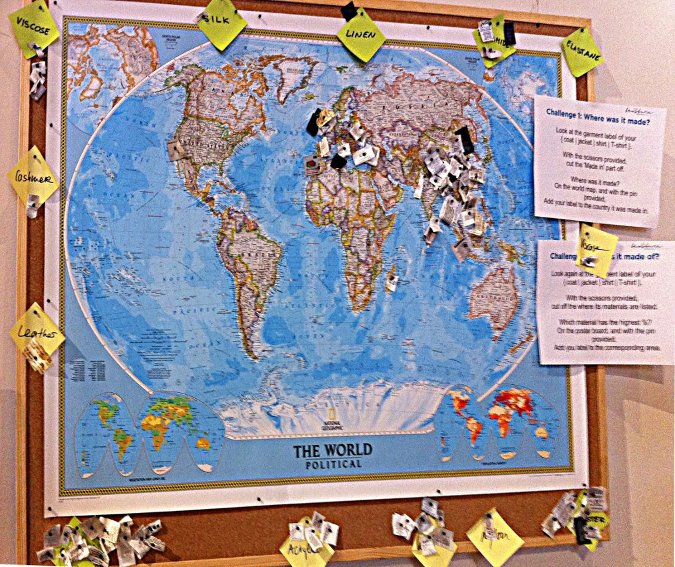 Recently, my colleague Ilaria Pasquinelli and I, had the opportunity to participate in a, generally speaking, consumer facing product showcase and trade show. This gave us the opportunity to interact with consumers in the mood of buying, and to investigate their knowledge, opinions and attitudes towards the clothes they wear and buy.
Recently, my colleague Ilaria Pasquinelli and I, had the opportunity to participate in a, generally speaking, consumer facing product showcase and trade show. This gave us the opportunity to interact with consumers in the mood of buying, and to investigate their knowledge, opinions and attitudes towards the clothes they wear and buy.
For the purpose of this research, we built an interactive task which required the visitors to cut off one of their garment labels (i.e. the washing instructions), and then pin it to a map attached to a cork board according to 2 dimensions:
– ‘Made in‘: Where the garment was manufactured.
– ‘Made from‘: What the primary material the garment was made of.
The results of this hands-on consumer research were both, expected in some, and surprising in some other, aspects

For starters, the actual results of the outcome was entirely logical (picture right).
– The vast majority of garments were made overseas in Asia, predominately in China.
– And: the majority of garments were either made out of polyester or alternatively cotton. Other oil-based man-made fibres (polyamide, acrylic etc.) came second.
More interesting was the result of the informal interviews and conversation we had with visitors. They proved that consumers are by far not as clueless as we (from the industry) assume them to be. In fact, at least those attending the fair, were fairly well clued up about the the reasons, pros and cons of outsourcing to overseas destinations.
Surprising? Yes, and no.
No, because I distinctly remember already as a kid being well aware that ‘Made in China’ (or Taiwan, Japan etc. as it were at the time) means, that companies on purpose go out of their way to a) reduce price but also b) purposely release control and remain ignorant about what may, or not, be happening in those far away place. I was pretty certain that the ‘Made in China’ tag of my Walkman, jeans wasn’t good news. But at the same time, I had no idea what else to do – all I had access to was after all made in those far away places.
In a sense, the experience we made at the trade fair was fairly exactly that: consumers that were little surprised that their specific garments, or the majority of garments, where made in Asia, in order to produce as cheap as possible. None of them did particularly appreciate it. But neither knew they how and where to find alternatives that were, if not cheap, at least affordable.
Suddenly the words ‘accessibility’ and ‘availability’ takes on a somewhat more clear, and precise, meaning.
In a similar manner, the people we spoke to were aware that oil-based man-made fibre were not the best of all choices. The surprised eyes were however many when explaining them that what for them seemed like a logic alternative – natural fibres such as specifically cotton – by not the best available option either. The most astonishing experience for us was the keen attention that our explanations were listened to, and the sometimes challenging questions we were asked.
How to explain why simply bringing production back to Europe may possibly open a wholly different can of worms? Why is it
– that brands bother less than they could do business ‘responsibly’?
– that ‘Made in…’ may potentially not mean much because legal frameworks still aren’t precise enough?
– that manufacturing jobs in Europe, notably in textiles, aren’t popular?
– that prices of ‘Made in Europe’ are fairly high, and often only interesting if the goods are bought directly with the designer/manufacturer?
– that the problem doesn’t start with the manufacturing of apparel or textiles, but much early, namely the availability of raw material?
– that their opinion supposedly count with retailers, when in fact they make the contrary experience on a daily level?
– that there aren’t more responsibly, ethically, sustainably produced products easily available because retailers don’t see it as their task to offer them?
The discussion we had over the course of nearly 4 days were specific, detailed, balanced, objective and coined by a genuine interest of attendees to understand what it is that they were buying and wearing. That there is interest to start engaging with a more story driven consumption approach – more quality, less quantity – became equally clear. The motivation is there – but at the same time many consumers admit that convenience remains key. Not (primarily) in terms of cash, but in terms of ‘where can I buy it’.
It feels, as if fashion textile brands should send their CEO and marketing executives more frequently into conversations with consumers to really feel their pulse. Something which is clearly lacking at this point.

